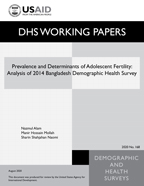- PUBLICATIONS
- JOURNAL ARTICLES
- ACCESS PUBLICATIONS
Publications Summary
- Document Type
- Working Papers
- Publication Topic(s)
- Fertility and Fertility Preferences
- Country(s)
- Bangladesh
- Survey
- Bangladesh DHS, 2014
- Language
- English
- Recommended Citation
- Alam, Nazmul, Manir Hossain Mollah, and Sharin Shahjahan Naomi. 2020. Prevalence and Determinants of Adolescent Fertility: Analysis of 2014 Bangladesh Demographic Health Survey. DHS Working Paper No. 168. Rockville, Maryland, USA: ICF.
- Download Citation
- RIS format / Text format / Endnote format
- Publication Date
- August 2020
- Publication ID
- WP168
Download
 Prevalence and Determinants of Adolescent Fertility: Analysis of 2014 Bangladesh Demographic and Health Survey (PDF, 553K)
Prevalence and Determinants of Adolescent Fertility: Analysis of 2014 Bangladesh Demographic and Health Survey (PDF, 553K)
Download this publication
There is no printed copy available to order.
